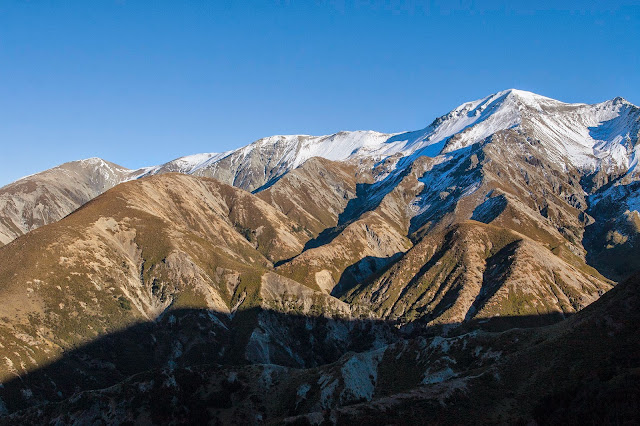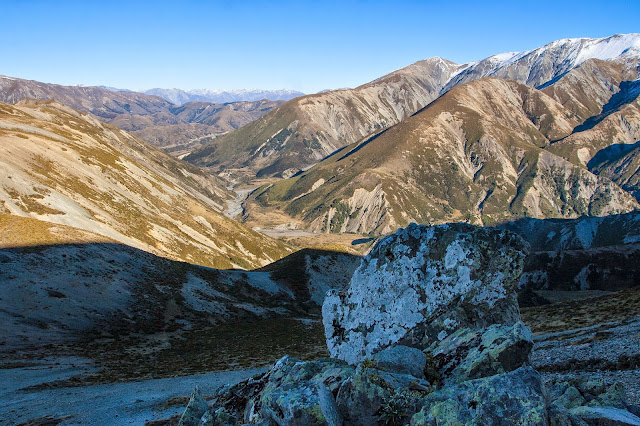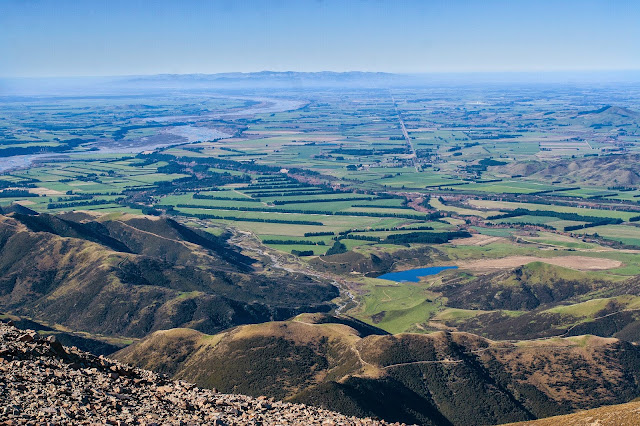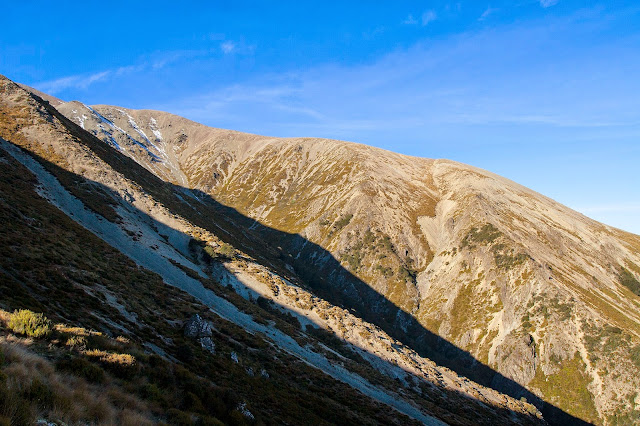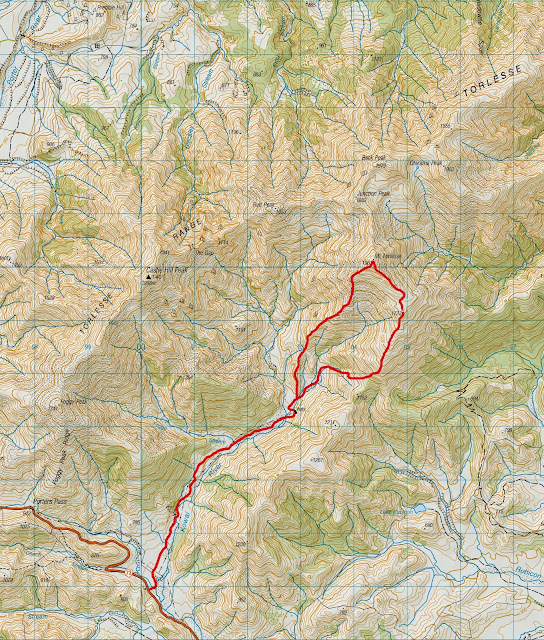So instead I headed for Mt Thomas, a more easterly summit along the line of foothills running close to where I live. The four commonly known ones are Oxford, Richardson, Thomas, and Grey, with Karetu sandwiched in next to Grey although it certainly doesn't receive the attention the others do, due to the fact that the main four are all well tracked by DOC.
Mt Thomas stands at 1023m, not a lofty height by any stretch, but to reach the summit still requires over 700m of altitude gain so is not to be completely trifled at.
There are numerous routes to the summit, all well tracked and marked. I decided on the steep, direct Summit Track, which climbs directly up to the summit from the carpark. With the wind slowly abating, I hoped avoid the worst of it while ascending, and then enjoy travelling the pleasant tops along to the Wooded Gully track in better conditions, and then descend that track back down to the carpark.
The Summit Track climbs in a series of steep steps, with sections at an easier gradient mixed in to ease the burden on the legs. Steepness is a relative term, as what I find steep others may not, or vice versa. In relation to other similar tracks in the area, this one is reasonably steep but for me, with my last trip being up Mt Torlesse, it paled in comparison and I found it to be rather easy going.
The track heads up through the extensive pine plantation on Mt Thomas, climbing steadily until breaking out of the bush at around the 900m contour. Here are the first decent views of the tramp, as the track sidles round the side of the ridge to join a forestry road shortly before the summit.
Leaving the protection of the bush, I was struck by the full force of the wind. While it had appeared to be easing down on the flat, that certainly wasn't the case at 1000m altitude. It wasn't dangerous, simply unpleasant, and made for bitterly cold conditions on the summit.
The views from such a modest summit are, on a nice, fine day, quite impressive. The Canterbury Plains stretch out before you, across to Christchurch, with Pegasus Bay clearly visible. Even here on an average day as I was there was much to see. The freshly snow dusted peaks of Mt Hutt, and the Torlesse and Puketeraki Ranges were all on show, albeit slightly shrouded in cloud, as well as the line of foothills all the way along to Mt Grey, and deeper into the hinterland of the upper Okuku River.
With the wind curtailing my time on the summit, I quickly set off across the open tops, planning to stop for a snack below bushline at the track junction. These tops are superb, snaking through typical alpine scrub, and offering an ever changing outlook on the surrounding area.
It's not far along the tops, and I reached the track junction in 25 minutes, pleased to have left the biting wind behind.
From the junction there are a couple of options on offer to return to the carpark. The most expedient route is the Wooded Gully track, which descends immediately down into the head of the valley, while a longer option if you're looking to extend your outing a little is to continue on the Ridge Track, climbing from the junction towards Pt 1043m before turning off and heading along the ridge top on the true right of Wooded Gully. This adds at least an hour onto your trip. A further extension, one perhaps best done as an overnight trip, is to carry on past the Ridge Track turnoff and on to Bob's Biv, a little 2 bunk bivvy nestled in the bush a couple of hours or so along the ridge. I haven't visited yet, but it looks to be a cosy wee spot - maybe next summer.
With things to do at home in the afternoon, I opted for the shorter Wooded Gully track. Initially it descended quite easily, zig-zagging down the steep head of the valley, before a bit lower down the track got rougher, eroded by water running down the face. In places the force of the water has actually washed out some steps built by DOC, the boards left strewn at the track edge.
As the track dropped down to the stream, the going became markedly easier, and this continued the closer I got to the carpark - probably due to the fact that several shorter loop tracks are found in the lower valley and the tracks are maintained to a higher standard to suit family groups. It makes sense, as most capable trampers considering going up to the summit should be able to handle a rougher track, while families (like ourselves!) will appreciate the well maintained track system in the lower valley - I know we have in the past bringing our young kids in here.
Before long I was back at the car, a nice half days exercise behind me.
 |
| Tops near Mt Thomas. Wooded Gully Track climbs to the saddle, while Mt Thomas summit is away to the right out of frame, Pt 1043m left of the saddle |
 |
| On the summit of Mt Thomas (1023m), looking along the foothills towards Mt Grey (far right) |
 |
| Trig on Mt Thomas |
 |
| Photo doesn't capture it well, but there was lovely sunlight hitting the snow on Mt Hutt (through the gap in trees centre image), Mt Oxford is through the gap on the right |
 |
| Looking across the plains to Christchurch and the Port Hills |
 |
| Tripod wouldn't stand in the wind, so had to just put the camera on the ground |
 |
| Pleasant tops running NW from the summit of Mt Thomas |
 |
| View to the west, Mt Oxford just right of centre, with the snow capped Torlesse Range immediately behind. The Ridge Track takes the bush spur running through the middle of image |
 |
| Looking back to Mt Thomas |
 |
| Further along the tops, Mt Thomas at left, with the Canterbury plains stretching out beyond |
 |
| The flat expanse that is the Canterbury plains, a pattern of squares when seen from above |
 |
| Last wide views of the trip, before dropping down to the bush saddle, Summit Track climbs up from the right |
 |
| Crown Copyright - Land Information NZ |
Access: From Oxford, drive out through Ashley Gorge, past Glentui, and turn left onto Hayland Rd. Alternatively, from Rangiora drive out to Loburn, turn left onto Hodgsons Rd and continue up towards Ashley Gorge, turning right onto Hayland Rd. There are large DOC signposts shortly before Hayland Rd on both sides of the approach. The carpark is at the end of the road, all other roads branching off Hayland are private.
Time: Carpark to Mt Thomas via Summit Track 1hr 20mins, summit to track junction 25mins, track junction to carpark via Wooded Gully Track 1hr 20mins
(Note: the electronic map I downloaded a couple of years ago from LINZ, used above, still uses the old track names Track 1 and Track 2, for the Summit & Ridge Tracks respectively. However the paper map uses the current track names as they appear on DOC signage. Also, the electronic version misnames Hayland Rd as Smiths Rd, again, the paper version is correct. These errors may have been corrected on subsequent updates to the electronic version)
Map: BW23 Cust
Hut: None












